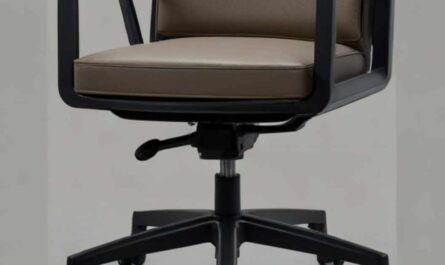In the modern workplace, office chairs are necessary for long hours of sitting, as these chairs are designed to provide comfort, support, and proper posture while working and completing tasks. However, as time passes and with daily use, office chairs may develop problems in their alignment. One of the most common problems is when these chairs start leaning to one side.
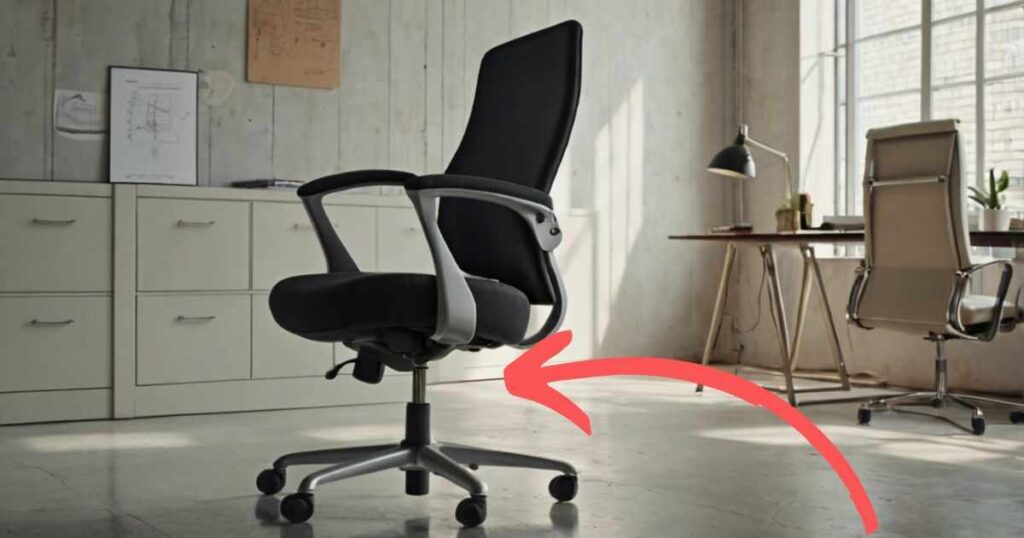
This causes disturbance, discomfort and also posture problems to the person sitting on it. So if you are also facing this problem and you don’t know how to fix it then this guide is for you. In this article, we will discuss how to fix an office chair leaning to one side.
Why Is My Office Chair Leaning to One Side?
The main reason for this problem is due to a loose or damaged component such as screws, bolts, gas cylinders, chair bases, seat plate mechanisms, and maybe the casters. These components hold the chair in place and maintain its stability. If any of these parts are damaged or loose, it may cause the chair to lean to one side. And you will need to repair or replace some parts.
Finding the Actual Problem
As we mentioned there can be different reasons behind the chair leaning problem. So before trying any solutions, it is important to identify the actual problem and understand which part needs to be fixed. Here are some steps you can follow for a thorough inspection:
1. Initial Inspection
First is to inspect generally, Look at the chair from different angles to identify any visible signs of damage or misalignment. Sit on the chair and carefully observe if it leans immediately, or if the leaning occurs over time. And see if there is any specific area where the chair seems to lean towards.
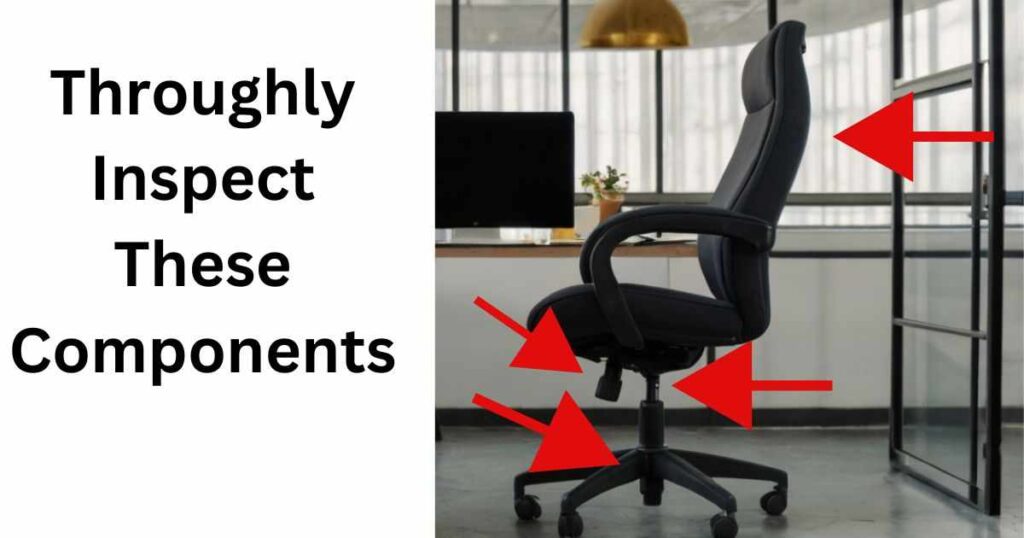
2. Checking for Loose Screws and Bolts
The other reason can be loose screws and bolts. To check this, turn the chair upside down and see if the screws are loose or missing.
3. Inspecting the Gas Cylinder
If the screws and bolts seem fine, then check the gas cylinder for damage or leakage. Sit on the chair while someone else checks from underneath if there is any leaking air or visible damage to the gas cylinder. If yes, you will need to replace it.
4. Examining the Chair Base
Next, examine the chair base properly that is under the seat (holding the wheels casters), and if you see any cracks or damage, then it may cause the chair to lean. In this case, you will need to repair or replace the chair base.
5. Assessing the Seat Plate Mechanism
If the base and other components are fine, next check the seat plate mechanism. See if it is aligned properly and not damaged, as this can also be cause.
6. Evaluating the Backrest Alignment
Next, check the backrest, by each side and see if it’s aligned properly. If not, then you will need to adjust the backrest according to your height and comfort.
7. Identifying Damaged Casters
Lastly check the casters, if they are all intact and not damaged.
Once you have determined your chair and identified the actual problem, now we are going to explain how to fix an office chair leaning to one side. So, after inspecting you know very well what you need to fix. So gather these tools and materials:
Tools, Materials, and Replacement Parts Needed
- Screwdriver
- Allen wrench
- Pliers
- Lubricant (e.g. WD-40)
- Cleaning supplies (e.g. cloth, mild soap)
Replacement parts: The above-mentioned tools are necessary for this procedure, however, you have inspected and you understand what replacement parts are needed. So gather all and let’s start the process:
How to Fix Your Office Chair Leaning to One Side? Step-by-Step Guide
1. Tightening Screws and Bolts
If the problem is with loose screws or bolts, tighten them using a screwdriver or Allen wrench. If any are missing, then replace them with new ones that you can buy from any online store.
2. Replacing the Gas Cylinder
If the gas cylinder is damaged or leaking, then you will need to replace it, you can read the detailed article on “gas cylinder replacement”. Otherwise, Follow these steps:
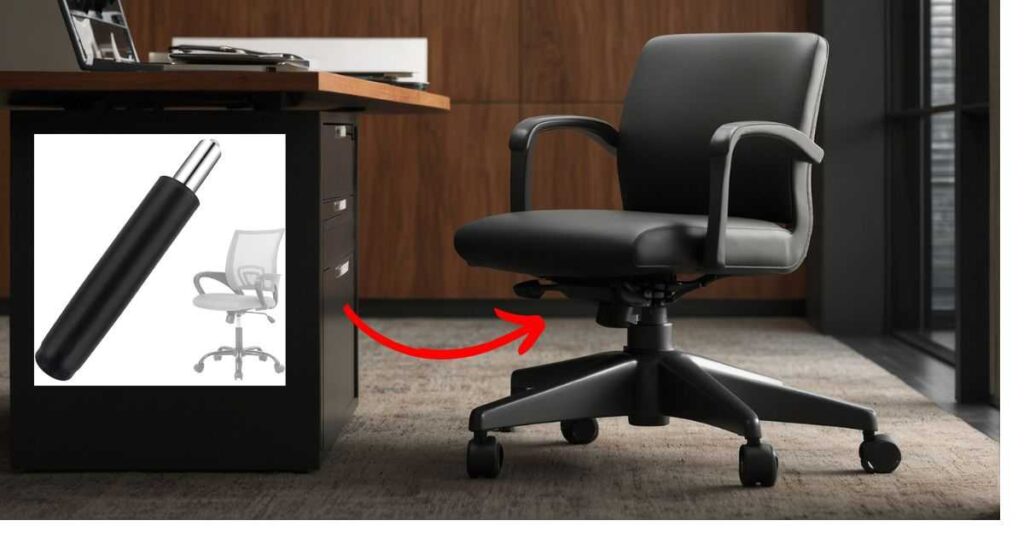
- Turn the chair upside down.
- Use pliers and pull out the old gas cylinder. If it is stuck, you can use WD-40 to loosen it.
- After removing the old one, clean the area and lubricate it for smoothness.
- Insert the new gas cylinder and push it into place by hand. You can also use a mallet to gently tap it in.
- Test the chair by sitting on it and adjusting the height. If it works properly, you have successfully replaced the gas cylinder.
3. Replacing the Chair Base
If the screws and gas cylinder, are all fine and you notice the problem in the base, then you will need to replace it with a new base that is compatible with your chair, Make sure to keep in mind these steps while purchasing a new one:
- Check for the correct size and weight capacity.
- Look for a sturdy and durable material such as metal or heavy-duty plastic.
- Make sure it is compatible with your current chair’s design.
- You can also opt for a swivel or non-swivel base depending on your preference.
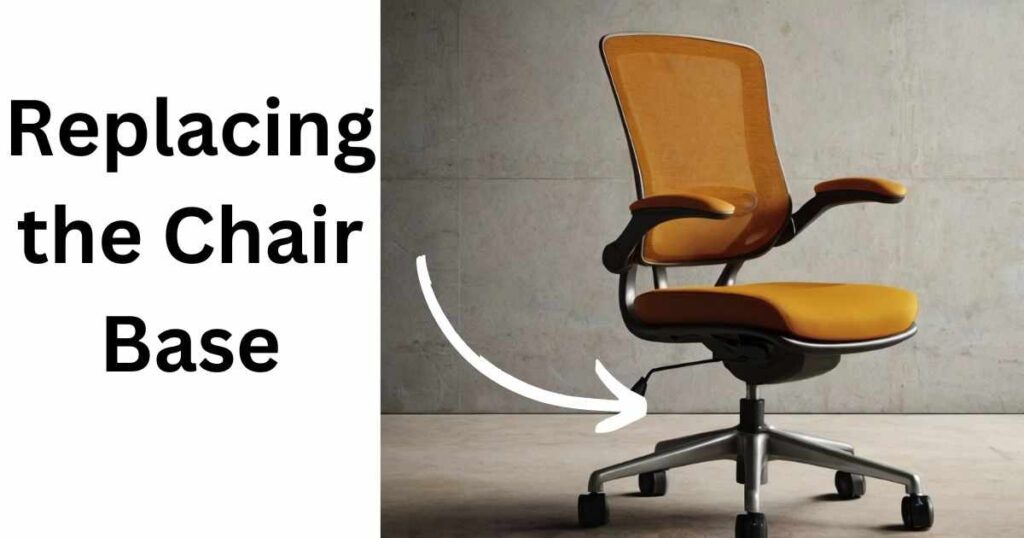
Once you have purchased the correct chair base, Follow these steps to attach it:
- Turn the chair upside down.
- Use Screwdriver or Allen wrench for unscrew and remove the base.
- Clean the area where you will attach the new base by wiping it with a cloth and mild soap. Make sure it is dry before proceeding.
- Take your new chair base and align it with the holes on the bottom of your chair’s seat plate. Slide it onto the gas cylinder, if applicable.
- Securely screw in the new base in place.
- Test the chair by sitting on it and also check its stability. If it is still leaning, then you should adjust and tighten it.
4. Adjusting the Seat Plate Mechanism
The next step is adjusting the seat plate mechanism. You just need to tighten the screws if it causing the problem, so take the screwdriver or Allen wrench and turn the chair upside down. And see the screws, attaching to it the seat plate. If they are loosened then tighten them properly.
5. Adjusting the Backrest Alignment
If your chair backrest causes the leaning to one side, then it can be easily adjusted and you can fix it by yourself. The backrest is attached to the seat plate through screws, so first locate all the screws that are attaching the backrest to the seat plate. Use a screwdriver to adjust them according to your desired angle and height, just make sure not to over-tighten them.
6. Replacing Damaged Casters
Lastly, if you have identified that casters are damaged or missing, then it is time to replace them. You can purchase replacement casters from any hardware or online store. Make sure while purchasing:
- You should check compatibility with your design.
- Choose durable and sturdy materials such as metal or heavy-duty plastic.
- Also, Check the weight capacity of each caster.

Once you have purchased the replacement casters, follow these steps to replace them:
- First, Remove the old caster by pulling it straight out from its socket or you can use pliers to pull it out.
- Clean the socket with a cloth and mild soap, then dry it.
- Take your new caster and push it straight into the socket, if you can’t push it in, you can use a rubber mallet to gently tap it in.
- Lastly, Test the chair by sitting on it and rolling around. See if all the casters are working properly and are evenly aligned.
Also Read: How to Clean Office Chair Wheels?
We have listed solutions that you can complete yourself, and we hope that your issue is resolved. But still, if you are having trouble or your chair has a different problem than the ones mentioned above, it is best to consult a professional for repair or replacement. However regular maintenance and care is important to prevent these issues in the future. So we have listed some of them:
How to Keep your office chair in good condition-Tips and Routine
- Regularly clean your chair with a cloth or clean it fully with mild soap.
- Whenever you feel any instability while sitting, then look for the screws and tighten them properly.
- Regularly lubricate the moving parts of your chair, such as the gas cylinder and casters, to prevent them from getting stuck or damaged.
- Periodically check for any loose screws or bolts and tighten them if needed.
- If your chair has a fabric or mesh seat, make sure to vacuum it regularly to remove any dust or debris that can accumulate over time.
- If possible, avoid placing heavy objects on your chair, as these can handle a certain limit of weight.
FAQs:
Can I use any lubricant for my office chair?
Not all lubricants are suitable for office chairs. It is recommended to use silicone-based lubricants or as we mentioned, you can use WD-40 for the moving parts of your chair. Avoid using petroleum-based lubricants or greasy substances as they can attract dust and dirt, making your chair more prone to damage.
Why is proper alignment important?
Proper alignment in an office chair is crucial for maintaining good posture and overall physical health. If you sit on the chair with incorrect alignment, it can lead to back pain, neck strain, and other musculoskeletal issues.
How do I know if I need to replace the gas cylinder on my office chair?
If you notice any leakage or damage in the gas cylinder, or if your chair is constantly sinking, then it’s time to replace the gas cylinder.
Conclusion
In conclusion, you have repaired your chair leaning to one side problem, by following the simple and easy steps mentioned in this guide. We hope that now you can sit comfortably in your chair without any discomfort or instability. However, it is important to regularly maintain some simple tips and routines to prevent any future issues.

